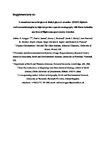Archaeal and bacterial glycerol dialkyl glycerol tetraether (GDGT) lipids in environmental samples by high temperature-gas chromatography with flame ionisation and time-of-flight mass spectrometry detection
| dc.contributor.author | Lengger, SK | |
| dc.contributor.author | Sutton, P | |
| dc.contributor.author | Rowland, S | |
| dc.contributor.author | Hurley, SJ | |
| dc.contributor.author | Pearson, A | |
| dc.contributor.author | Naafs, BDA | |
| dc.contributor.author | Dang, X | |
| dc.contributor.author | Inglis, GN | |
| dc.contributor.author | Pancost, RD | |
| dc.date.accessioned | 2018-04-13T17:53:53Z | |
| dc.date.issued | 2018-07 | |
| dc.identifier.issn | 0146-6380 | |
| dc.identifier.issn | 1873-5290 | |
| dc.identifier.uri | http://hdl.handle.net/10026.1/11273 | |
| dc.description.abstract |
Archaeal isoprenoidal glycerol dibiphytanyl glycerol tetraether lipids (iGDGTs) and their non-isoprenoidal branched bacterial analogues (brGDGTs) have widespread applications in biogeochemistry and paleothermometry. Analysis of GDGTs usually involves separation using high performance liquid chromatography, typically coupled via atmospheric pressure chemical ionisation to mass spectrometric detection in selected ion-monitoring mode (HPLC–APCI-MS). However, reliable determination of ratios and, in particular, quantification by this technique, can be challenging due to differences in ionisation efficiencies of the various compounds. Quantification of GDGTs also relies on external calibration of the relative response to an internal standard with authenticated GDGTs, which are often not readily accessible. Here, we tested the suitability of high temperature gas chromatography with flame ionisation detection (HTGC-FID) for the determination of concentrations and tetraether lipid-based ratios in marine and terrestrial samples. For this, we identified GDGTs in environmental samples using HTGC coupled to time-of-flight mass spectrometry (HTGC–MS). Using a purified GDGT standard, we show we can quantify GDGT-0 in environmental samples by GC-FID. Some GDGT-based ratios measured by HTGC-FID exhibited a linear correlation (1:1) with ratios derived from HPLC–MS and weight-based ratios of mixtures of purified standards. However, ratios relying on minor isomers, such as TEX86 and MBT/CBT have many unresolved challenges for determination by HTGC. Detection limits were higher than for HPLC–MS. However, the advantages of employing HTGC-based methods include: (1) the independence from MS tuning-related differences in ionisation energies; (2) the potential for direct comparison with other, non-GDGT based biomarkers; and (3) a more complete insight into biomarker distributions in environmental samples by the extension of the temperature range. Quantitative elution of GDGTs from a HTGC column as demonstrated herein, will also enable their analysis by compound-specific isotope ratio mass spectrometry. | |
| dc.format.extent | 10-21 | |
| dc.language | en | |
| dc.language.iso | en | |
| dc.publisher | Elsevier | |
| dc.subject | 3401 Analytical Chemistry | |
| dc.subject | 34 Chemical Sciences | |
| dc.title | Archaeal and bacterial glycerol dialkyl glycerol tetraether (GDGT) lipids in environmental samples by high temperature-gas chromatography with flame ionisation and time-of-flight mass spectrometry detection | |
| dc.type | journal-article | |
| dc.type | Article | |
| plymouth.volume | 121 | |
| plymouth.publication-status | Published | |
| plymouth.journal | Organic Geochemistry | |
| dc.identifier.doi | 10.1016/j.orggeochem.2018.03.012 | |
| plymouth.organisational-group | /Plymouth | |
| plymouth.organisational-group | /Plymouth/Faculty of Science and Engineering | |
| plymouth.organisational-group | /Plymouth/REF 2021 Researchers by UoA | |
| plymouth.organisational-group | /Plymouth/REF 2021 Researchers by UoA/UoA07 Earth Systems and Environmental Sciences | |
| plymouth.organisational-group | /Plymouth/Research Groups | |
| plymouth.organisational-group | /Plymouth/Research Groups/Marine Institute | |
| plymouth.organisational-group | /Plymouth/Users by role | |
| dcterms.dateAccepted | 2018-03-22 | |
| dc.rights.embargodate | 2019-3-28 | |
| dc.identifier.eissn | 1873-5290 | |
| dc.rights.embargoperiod | 12 months | |
| rioxxterms.versionofrecord | 10.1016/j.orggeochem.2018.03.012 | |
| rioxxterms.licenseref.uri | http://www.rioxx.net/licenses/under-embargo-all-rights-reserved | |
| rioxxterms.licenseref.startdate | 2018-07 | |
| rioxxterms.type | Journal Article/Review |



